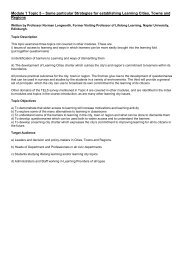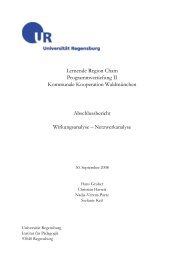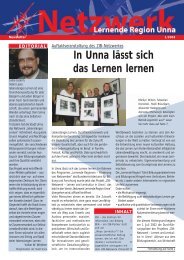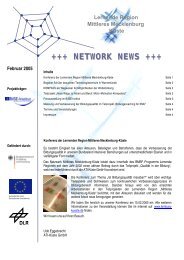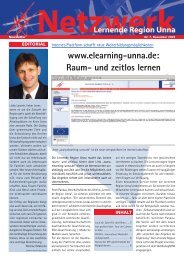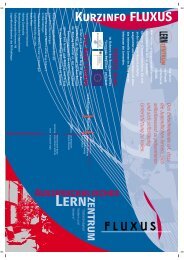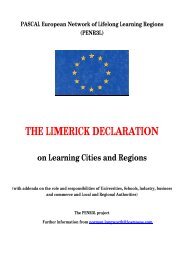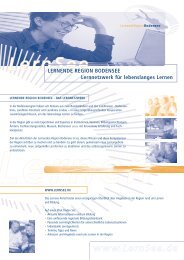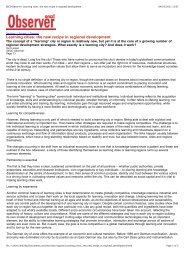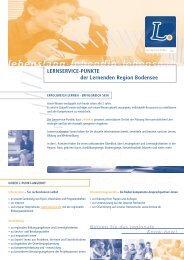SWOT-analysis as a basis for regional strategies - EUROlocal
SWOT-analysis as a basis for regional strategies - EUROlocal
SWOT-analysis as a basis for regional strategies - EUROlocal
Create successful ePaper yourself
Turn your PDF publications into a flip-book with our unique Google optimized e-Paper software.
2. <strong>SWOT</strong> within the context of strategic management<br />
<strong>SWOT</strong> <strong>analysis</strong> can hardly be discussed without linking it to the broader prescriptions<br />
of strategic management. As Igor Ansoff (1980) postulates, strategic management is<br />
to a great extent an exercise of adjusting an organisation’s internal behaviour to bring<br />
about necessary changes in its interaction with the surrounding environment.<br />
Moreover – and this makes Ansoff’s ide<strong>as</strong> particularly useful in this study – he argues<br />
<strong>for</strong> widening the organisational scope of strategic management from enterprises to all<br />
organisations fulfilling a criterion derived from his first postulate. He speaks<br />
deliberately about environment-serving organisations, including both “<strong>for</strong>-profit”<br />
firms and “not-<strong>for</strong>-profit” agencies (ibid: 8).<br />
Today, <strong>as</strong> w<strong>as</strong> the c<strong>as</strong>e already twenty years ago when Ansoff’s book w<strong>as</strong> published,<br />
the difference between the two categories h<strong>as</strong> become extremely vague. This<br />
challenges the stereotype images of various types of organisations. Giant enterprises<br />
can be bureaucratic dinosaurs matching any caricature of traditional public<br />
administration, where<strong>as</strong> units and agencies within the public administrative apparatus<br />
can show high degrees of efficiency, flexibility and creativity, all emblems willingly<br />
attached to private enterprises.<br />
In the era of globalisation the factors that lead to an incre<strong>as</strong>ing rate of organisational<br />
complexity have changed. In the traditional industrial economy complexity grew<br />
typically <strong>as</strong> a consequence of quantitative growth of the organisation. Higher output<br />
w<strong>as</strong> achieved by mobilising more production factors. A more recent phenomenon,<br />
more and more relevant to today’s organisations, is the cultural dimension (cf.<br />
Ghoshal & Bartlett 1998). Both business and public organisations operate in an<br />
incre<strong>as</strong>ingly multicultural environment and face a need <strong>for</strong> replacing at le<strong>as</strong>t parts of<br />
the nationally differentiated decision-making processes with global ones.<br />
In Ansoff’s definitions the environment – interpreted <strong>as</strong> the institutional order<br />
surrounding an organisation (Karppi 1996; 1999) – h<strong>as</strong> a particular status. In fact the<br />
success of an organisation in arranging its relationship with its environment <strong>as</strong> a<br />
meaningful exchange of inputs and outputs can be seen <strong>as</strong> an issue that legitimises the<br />
organisation’s very existence. Thus, deriving a systematic set of principles and<br />
methods to arrange the relationship between an organisation’s internal processes and<br />
its environment is a key t<strong>as</strong>k <strong>for</strong> strategic management.<br />
Even if all notions about convergence of models crossing either national/cultural<br />
boundaries or the division lines between different organisational types are highly<br />
re<strong>as</strong>onable, there is one fundamental distinction that makes the difference between<br />
private and public organisations rather dramatic. The core of this distinction lies in the<br />
organisation’s ability to adjust its internal structure to in<strong>for</strong>mation received from the<br />
environment. For private business organisations these adjustments have to be a<br />
continuous process, literally a question of life and death, <strong>as</strong> they are dependent on<br />
market relations, most of which are beyond the organisation’s immediate control.<br />
Instead, and particularly in the <strong>as</strong>sumptions of neo-cl<strong>as</strong>sical orthodoxy, these relations<br />
are a battleground of innumerable economic agents whose open and unconstrained<br />
competition produces market equilibrium.<br />
21



